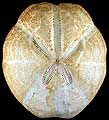| Species Included |
-
Large numbers of species have been assigned to this genus, including:
-
B. aguayoi Sanchez Roig, 1952; Oligo-Miocene, Cuba
-
B. jimenoi Cotteau; early or middle Miocene, Cuba, Trinidad
-
B.lyrifera (Forbes, 1841); Miocene to Recent, NE Atlantic; Upper Miocene, Morocco, Pliocene of Italy
-
Brissopsis duciei Wright, 1855. Miocene, Mediterranean
-
B. atlantica Mortensen, 1907; Recent, Caribbean, Atlantic
-
B. mediterranea Mortensen, 1913; Miocene to Recent, Atlantic, Mediterranean
-
B. pacifica (Agassiz, 1898); Recent, East Pacific
-
B. elongata Mortensen, 1907; Recent, Venezuela, Panama
-
B. obliqua Mortensen, 1948; Recent, Philippines
-
B. evanescens Mortensen, 1950; Recent, South Africa
-
B. jarlii Mortensen, 1951; Recent, Gulf of Guinea
-
B. alta Mortensen, 1907; Recent, Gulf of Mexico
-
B. columbaris Agassiz, 1898; Recent, West coast of Americas from California to Ecuador
-
B. zealandiae Mortensen, 1921; Recent, New Zealand
-
B. luzonica (Gray, 1851); Recent, Indo-West Pacific
-
B. similis Mortensen, 1948; Recent, Philippines
-
B. micropetala Mortensen, 1948; Recent, Philippines
-
B. oldhami Alcock, 1893; Recent, Indian Ocean
-
B. bengalensis Koehler, 1914; Recent, Indian Ocean
-
B. parallela Koehler, 1914; Recent, Indian Ocean
-
B. blanpiedi Grant & Hertlein; Oligocene, USA
-
?B. mortenseni (Sanchez Roig, 1952); Oligo-Miocene, Cuba
-
?B. durhami Fischer, 1985; Middle Miocene, Costa Rica
-
B. praeluzonica Fell, 1964; Oligocene, Australia, New Zealand.
-
B. tatei Hall, 1907; Lower Miocene, southern Australia.
-
B. crescenticus Wright, 1856; Miocene, Mediterranean
|
| Remarks |
Distinguished from Metalia and Plagiobrissus in having a bilobed rather than shield-shaped subanal fasciole, and in having a subcentral apical disc, which makes the posterior petals generally shorter than the anterior petals. In Metalia and Plagiobrissus the posterior petals are much longer than the anterior pair. Rhinobrissus also differs in having a shield-shaped subanal fasciole, and its anterior petals are much more widely divergent.
An excellent revision of the Atlantic and Caribbean species has been given by Chesher (1968) and Coppard (2008).
Coppard, S. E. 2008. A comparative analysis of the spatangoid echinoid genera Brissopsis and Metalia: a new genus and species of spatangoid (Echinodermata: Echinoidea: Brissopsidae) from the Philippines and the reassignment of Brissopsis persica to Metalia. Zootaxa 1760, 1-23.
Mortensen, T. 1950. A monograph on the Echinoidea. V, Spatangoida 2. C. A. Reitzel, Copenhagen.
Agassiz, L. 1840. Catalogus systematicus Ectyporum Echinodermatum fossilium Musei Neocomiensis, secundum ordinem zoologicum dispositus; adjectis synonymis recentioribus, nec non stratis et locis in quibus reperiuntur. Sequuntur characteres diagnostici generum novorum vel minus cognitorum, 20 pp. Oliv. Petitpierre, Neuchâtel.
Chesher, R. H. 1968. The systematics of sympatric species in West Indian spatangoids: a revision of the genera Brissopsis, Plethotaenia, Paleopneustes, and Saviniaster. Studies in Tropical Oceanography 7, 1-168, pls 1-35.
|





